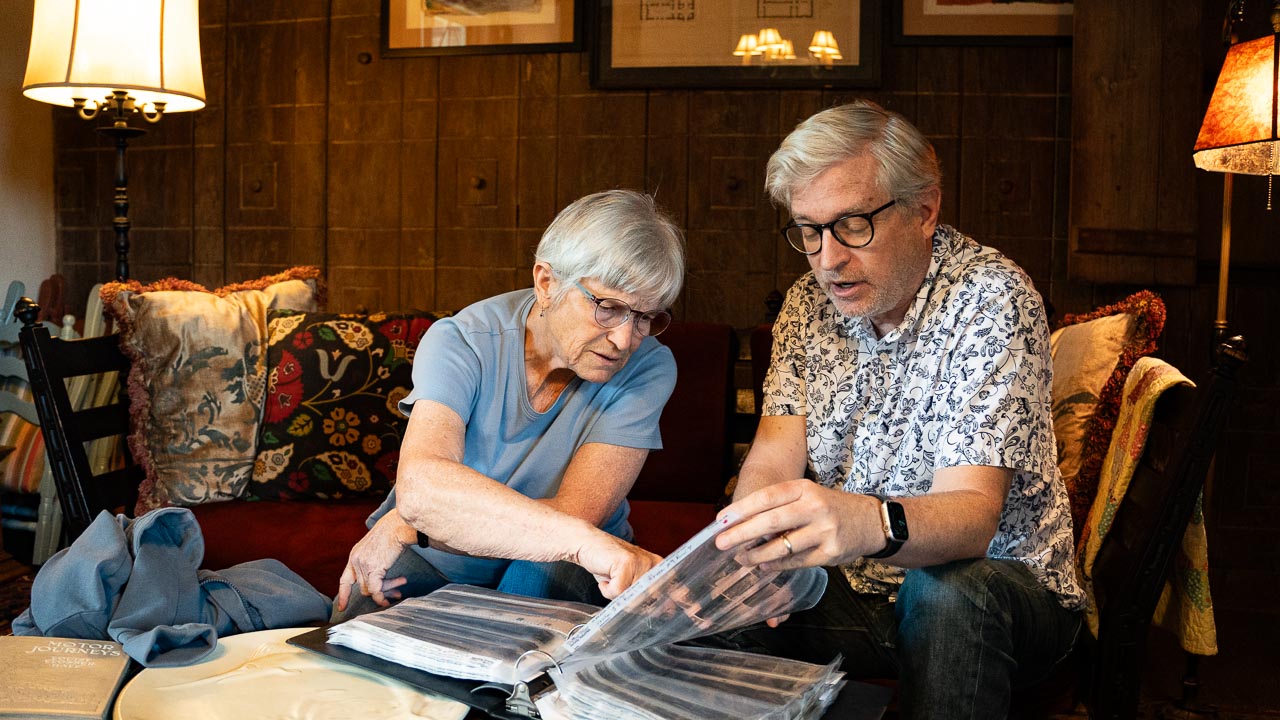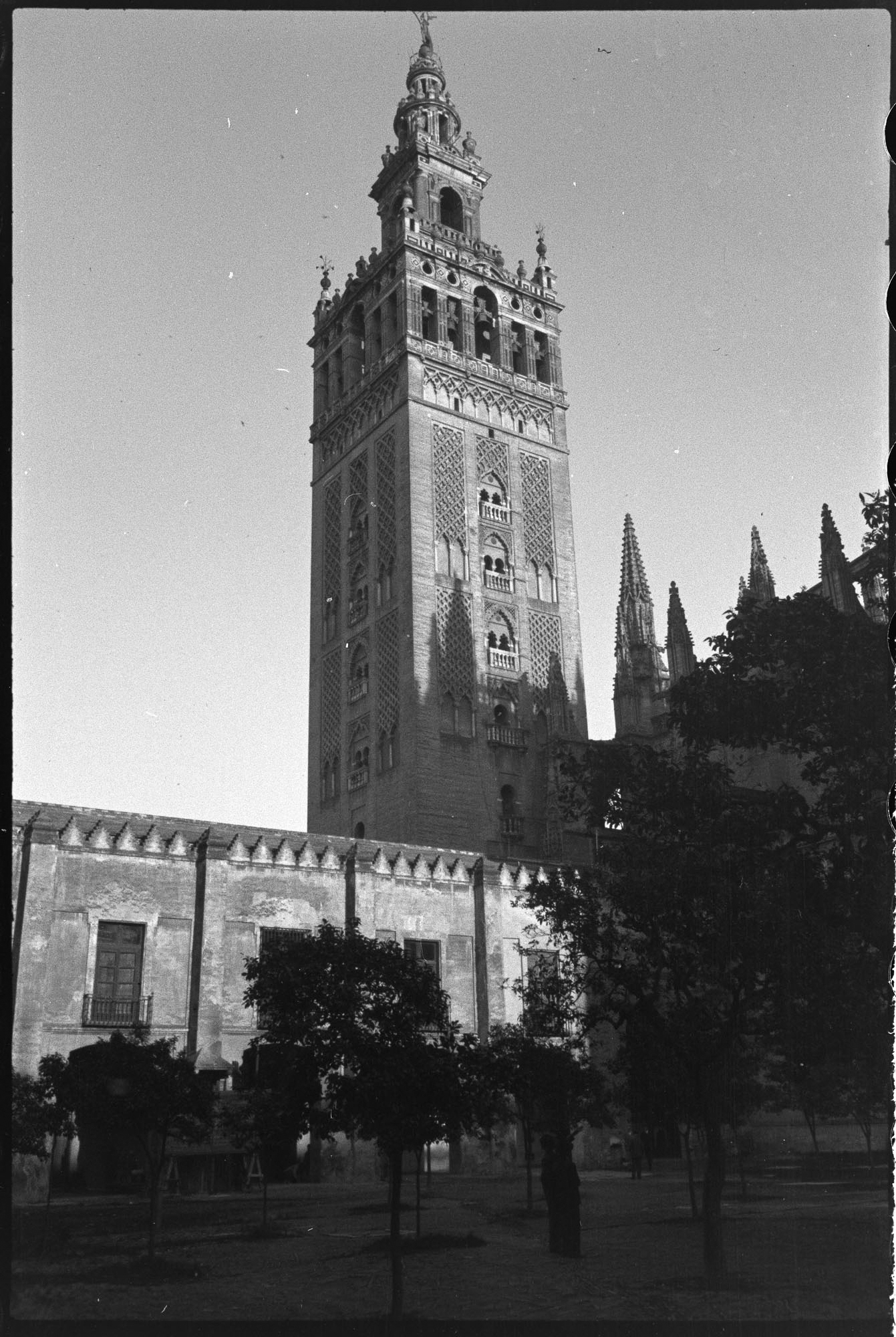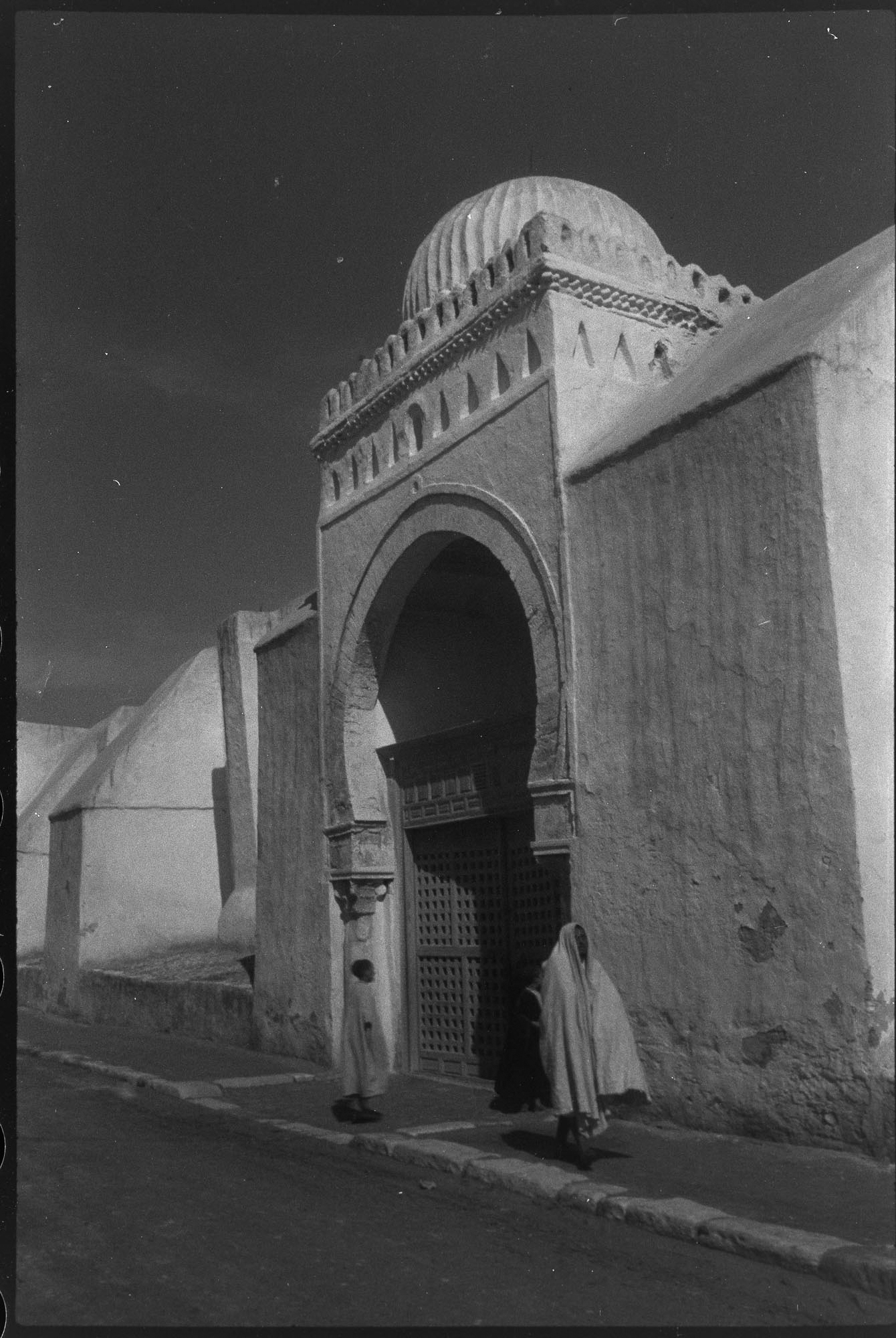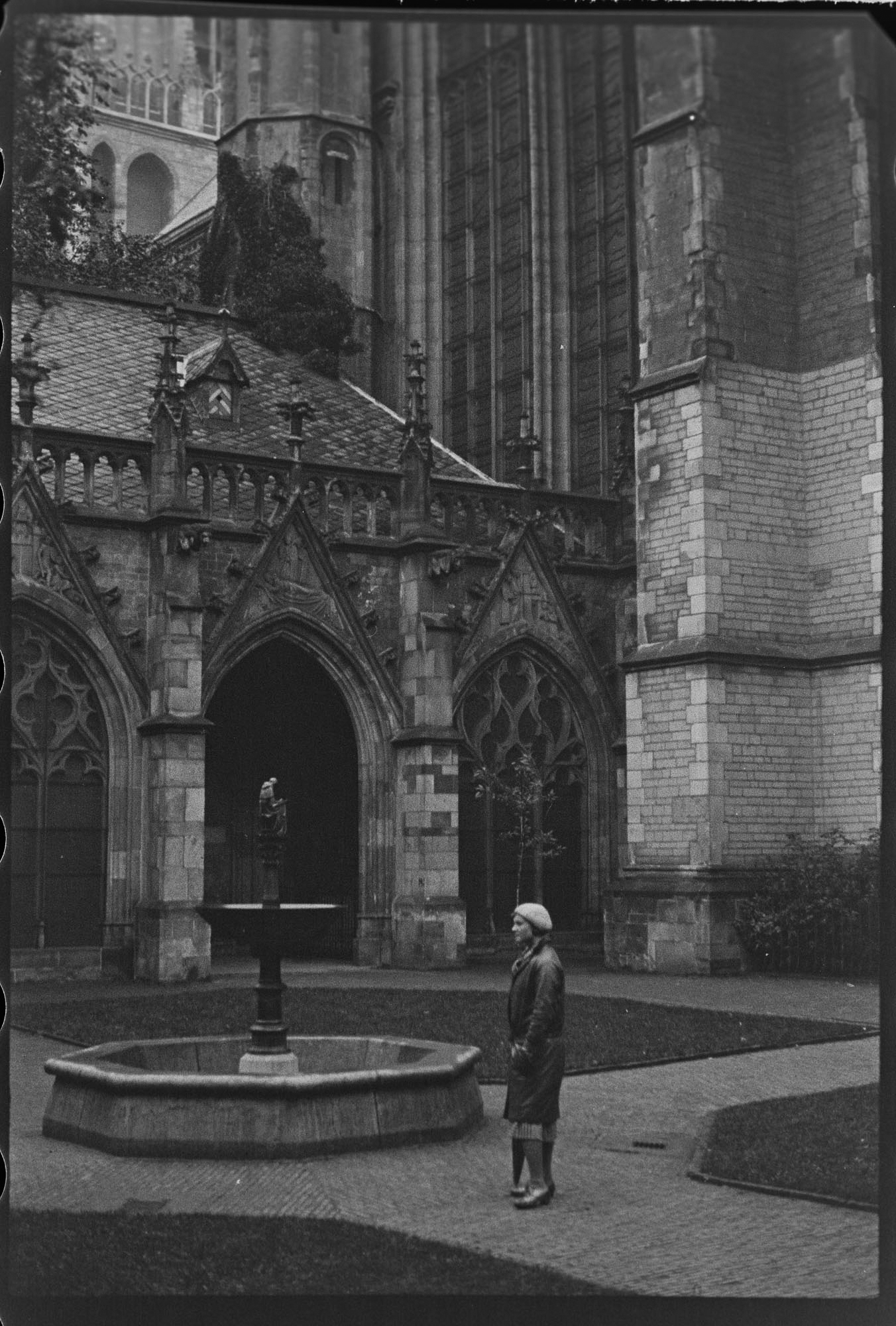
Peter Weber is undoubtedly one of our city’s most important architects and when you consider commercial structures alone, is quite possibly the single most important architect. He was the lead draftsman and designer of the G. Stanley Wilson firm (think the Mission Inn Hotel, Aurea Vista, Riverside Arlington Heights Fruit Exchange) and so was responsible for some significant and beautiful contributions to our Downtown’s built environment. Ten of his designs for the Wilson firm are listed on the National Register of Historic Places, and many more are local landmarks. In 1931 he married Clara Hartnett, who he would spend the rest of his life with and they embarked on a 14 month honeymoon across Europe and North Africa. They visited remote villages and major capitals and documented through photography the whole journey! The story doesn’t stop there however. Nearly 100 years later, and with the generous cooperation from the Weber family, Dave Stolte and Ruth West from The Old Riverside Foundation have been working diligently and tirelessly to unearth this photo archive for all of us to enjoy. I recently sat with Dave and Ruth in the living room of Peter Weber’s own home and interviewed them about this process. I was fascinated with what I learned and I think you will be too.

A Bit of Background
Peter Weber worked for the G. Stanley Wilson firm from 1918 until the firm closed in 1955. He was responsible for the designs of the final Mission Inn expansion in 1928 - 1931 (The International Rotunda Wing and Author's Row) and many of the City’s civic structures. His travels give us a bit more insight into his architectural knowledge which can help us pick out details in his buildings that we may not have recognized before.

The Interview
Dave began by explaining how he first learned about this photo archive from Weber’s son, Peter N. Weber. He had noticed a few photos of Peter and Clara in the Weber House and had always wondered where they were taken. “We had this family story that they were traveling for 14 months, and I thought, ‘are there more photos?’ turns out there were and there’s a whole backstory to that," Dave said. Besides being the designer for the Wilson firm Peter was also the photographer. Not only was he adept at using a camera which was fairly new technology at the time but he also had a great eye for composition. Dave continued to talk while Ruth got up and grabbed something out of the adjacent cabinet. Peter and Clara had just married, drove across the country, took a ship to France and when they arrived, they purchased a Leica Model 1C camera. Ruth hands me over a red box and takes over the conversation beginning to explain how Old Riverside Foundation had acquired a vintage Leica, the same model Peter used, to help understand more about these photos. She has been a photographer for a long time and is fascinated with not only the camera he used but the way he used it. She discusses how the viewfinder is slightly off-center so Peter would have had to account for that when composing each photo. This Leica 1C was one of the first mass produced consumer cameras in the world and Weber bought it in Europe because it wasn’t readily available in the U.S at the time. I could tell that for her this experience has so many layers, one being the fact that she is exploring original travel photography in the negative, from a very special vintage camera that just so happens to be in near mint condition. Dave then explained while on the trip, Peter took with him canisters of developer and fixer and each evening he would process the film, wrap it into rolls, make a note on the wrapper of where he was and what he had done that day and then put them aside in a box, “and there they stayed for 70 years.” Dave and Ruth made this comment at the same time, drawing out the sentence, still in disbelief of that fact. Peter never looked at those photos for the rest of his life. He passed away before he did anything with them, with the exception of one roll from Ireland that he developed to show his mother who was originally from Ireland. In 2002, his son Peter N. found them in storage, still wrapped in paper, still notated where they were taken. He began to process them, create an inventory and scan the photos that he found interesting. He managed to get through about a 1000 of them while the rest sat in storage. When Peter N. passed away the family came to Riverside for a memorial and it was during that time where the conversation began with Peter’s daughters about this photo archive. About 2 more years passed and periodically Dave or Ruth would follow up, trying not to bother them too much. Eventually they drove up to the Bay Area on a research trip into Peter’s life and while they were up there they paid a visit to one daughter and Connie Weber, Peter N.’s widow. When they arrived one of the daughters showed up with two canvas bags full of all the negatives and handed them over for Dave and Ruth to work with. “We didn’t know what kind of condition they would be in, we didn’t even really know what we were getting into,” Dave explained. They proceeded to explain how grateful they are to have the opportunity to go through this archive and made sure to cover that the intention is to treat these photographs with the utmost respect for the whole family, “We are very careful, everything that we do that involves any kind of history about Peter or their family, we clear it through them because we respect their privacy,” added Ruth.




Though I already knew about it and had seen most of the photos, as they were explaining their first encounter with the negatives it all felt new again. I wanted to jump right into the impact of this experience so I asked each of them, with their photography and design backgrounds what was most striking about these images. “The composition,” Ruth said without hesitation. “He wasn’t there just to look at the architecture, he was there to absorb the cultures. I think. That’s one way to put it, I guess.” I just have to say, as a side note, I love how Ruth makes these statements. She likes to leave the door open for other opinions, not making strong statements, however for me this makes her opinion all the more intriguing. She then explained how he took a lot of architectural photos but also had a habit of finding the highest ground within a city and getting great aerial shots, “and Clara would go right with him!” At that time the Fascists were in power in Italy and he captured some of that. He also captured a lot of the poverty from the Great Depression but also you see the beginnings of the transition to the modern world. Ruth gets up and hands me a photo from Algeria where you can see a brand new gas station while a couple of men walking through with several donkeys. He was able to capture a world in transition. Dave explains how he also had an eye for spur of the moment photos, catching light and shadows or capturing photos to show scale, like a person next to a very tall building. It shows that Peter had an artistic eye, one not just for capturing more intentional photos of specific places and things but also one for spontaneity. “He’s pointing the camera where he feels it deserves to be pointed so you can start to read into that and see what it is that made him tick. The story that we want to tell isn’t just about his great architectural accomplishments, we want to understand more about the man behind them.”





Peter and Clara purchased souvenir photos while they were away and Ruth and Dave have seen some of these but Ruth feels that Peter’s photos are much more impressive, mostly because his photos capture the everyday, back alleys and side streets, children playing. Real life. Dave explains how the largest grouping of photos that he took was in Spain because, of course, Riverside’s architecture at the time was Spanish and Mission Revival. Peter’s background was Beaux Arts so he was able to wrap together classical elements with Mediterranean styles like Italian and Spanish. After his travels he brought back a lot of North African and Moorish styles and motifs. That North African style is most prevalent in his own home but also shows up in commercial work as well. Possibly the most notable example being the San Bernardino Valley College auditorium. It features painted and carved wood with an Islamic 8 pointed star at the center of the auditorium. Given Peter’s fascination with the style I was curious to hear why they felt our city has very little of this influence and the consensus was that the people funding the projects at the time were not particularly interested in the style. Dave made an interesting point, proposing the idea that we probably look at a lot of design and classify it as Spanish even though the origins are actually Moorish or more broadly Mediterranean. Dave then explained how going through the archive with one of our local historians has expanded his architectural understanding and has caused him to see new facets of Riverside’s historic buildings. He then said, “Travel expands the mind and once expanded never returns to its original dimensions.” It seems vicarious travel can have a similar effect. I asked them both how this experience has affected them and didn’t really expect the answer that I got. “For me,” Ruth started, with tears welling up in her eyes, “it’s such an honor.” Her hands raised up as if to apologize for getting emotional and Dave stepped in, “it really is, we get emotional about it, absolutely. It’s such a privilege, the more we spend time with these images and the more people we share them with we realize what a treasure we have here and the goal is to make it available to the world.” They in unison explained that they are the first people to ever see these photos, not even Peter Weber looked at them. Dave took a deep breath and paused, making sure he worded his next statement correctly. “Peter…I think he was obsessive.” Ruth, though saying nothing, agreed with exaggerated head nods. “He had a card catalog system for the Weber House so if he wanted to know where a book was he would go to his index file and know exactly what shelf it was on. It was on A-4, or whatever.” He said as he reached into the air picking a book from an imaginary shelf. He went on to discuss that Peter was a compulsive collector of things and though it came in quite useful as a character trait while building his house it became more compulsive for him in his later years. “Doing this project, processing over 8000 photos, as a volunteer…the draw and the allure of these photos and the reward. I’m not just taking Ruth’s scan and converting them to positives and adjusting the levels. I’m also researching exactly where each photo was shot and then figuring out the route that they took, and where they went in sequence as a part of the inventory and documentation of this archive, getting that information connected to each image. There’s a level of obsession,” he nodded, with a look of perhaps, guilt, “that’s involved in that and it’s kind of a cautionary tale for me, to look at Peter, this very accomplished person that I’d never met but admire so much and to,” he paused to prepare his next words, “remind myself not to go too far.” Ruth had been non-verbally agreeing with Dave as he spoke. It was clear that she has been feeling the same way so I was curious to see what she now had to say.



She began, “This Weber House is more and more of a treasure the more we do this research. I’m also really focusing a lot on Clara’s contribution to a lot of this stuff.” She began to explain different aspects of their lives such as their lengthy marriage of 51 years, having her step mother living with them, sleeping outside and the wonderful kitchen that she is quite sure was built as a result of Clara’s requests. Ruth is fascinated with this couple and going through these photos is trying to decipher more about who they are. She goes on to explain how, in trying to respect their salvage values, when the Old Riverside Foundation re-landscaped an area of the Weber House they incorporated used bricks that were donated and have also begun to “stage” the home to look more like it was when they lived there rather than a museum. It’s clear that she has been enjoying this process and has grown so much closer to the people and now to the house. “People joke with me that now I have two homes,” she said with a laugh. “I agree with Dave, he's been obsessive but that obsession has helped him to do a remarkable job at an impossible task.”

My next question was whether they noticed a difference in Peter’s work from before and after his travels. The primary difference in his work when he returned was the Moorish influence, they both explained. It was fresh in his mind and so it found its way into a few projects that would allow for it. It was fascinating to consider his own house, the only property where he had complete creative control and could choose exactly what he wanted. Dave explained that he was adept at Spanish Revival which was popular in the mainstream but for his house he wanted to go older, more “medieval.” Ruth included that he enjoyed the Spanish architecture from when the Moors ruled Spain and incorporated a lot of their design motifs into his home. They then added, outside of just the aesthetic design, the fact that he designed the home to heat and cool naturally and even built a solar water heater. It’s likely that he saw on his travels ancient villages whose properties function in similar ways and have functioned that way for hundreds of years. “On their honeymoon they saw villas and castles, and palazzos, cathedrals and all this fabulous architecture and yet the style that he chose for himself that resonated with him, and what felt like home to him was a very humble medieval spanish home in the countryside,” said Dave. Ruth continued, “He took a lot of pictures in the small rural villages. Everyday pictures of the laundry being hung, doing laundry by the river, the everyday common person’s life. Dogs and cats. Street kids.” Ruth paused and said with amazement as if it just hit her, “oh, and then there’s North Africa,” and she put her hands up, “so interesting.” Dave adds, “that was the biggest surprise for me, the North African stuff.” They begin to explain their experience going through these photos, seeing unusual places, people and activities; not just the architecture. It was apparent to me that his experience was so striking that the surprise was conveyed through his photos for Dave and Ruth a hundred years later! I offered the thought that maybe that’s why he chose this style for his own house, it may have been a reminder of an experience he and Clara were really impacted by. They continued with their experience of some of the photos explaining how he captured such beauty in religious architecture but also such extreme poverty. Dusty, dirty streets, broken and crumbling homes, kids running out with bare feet and ragged clothes but appearing to be so happy.

I wanted to know what they learned that was most striking for them after going through the photos and I got another answer that I wasn’t expecting. Again it was his obsessiveness. They explained how some rolls of photos were nothing but wrought iron transoms, or another day, nothing but well heads or fountains. Shooting and re-shooting the same locations several times. Outside of his obsessiveness I was curious to know more about the content of the pictures and what that said about Peter. Knowing what Dave and Ruth know about Peter Weber’s past, the fact that he was planning to study in Paris before the Great War, that he read, “Motor Journeys” by Louis Hale and his experiences as a young man traveling they feel that Peter had a long list of architecturally-significant places he would have had on his ‘bucket list.’ Some of their favorite photos however, were of random villages, people and unidentifiable places. In many chapters of Motor Journeys, there is celebration of chance, of cool places to be found in-between the planned places. Although Peter was very structured in certain aspects of his life, Ruth and Dave believe he also made room for chance and for exploration while on this journey with Clara.

We then moved on to the monumental process of handling this archive. I was already so impressed with their obvious professional-level treatment of the archive, the cataloging and quality of the photos that I couldn't wait to hear more about what they’ve been up to. They received three ring binders with pages of negatives in rows of 6. Some of the negatives were damaged, all were heavily curled and none of them had any more protection than the plastic they were being held in. Ruth has transferred the negatives to archival-quality boxes with more room for the filmstrips, always handling them with special gloves that they were advised to use by the Museum of Riverside and uses different weights or books to begin to flatten them. She cuts paper to size and places them behind the negative before putting them back into the folders with red dots on the paper to show that they’ve been scanned. The film is in excellent condition given the fact that it’s over 90 years old, with most looking like they were just shot yesterday. They explain that Peter had to purchase 50 foot rolls since they weren’t available in canisters. He would cut the film, create a roll of usually between 35 and 40 pictures. They’ve noticed slight differences in pictures between the various types of film he purchased and also, interestingly, a variation based on the water he used to develop the film. In some areas, especially from Africa to Spain, there is a significant improvement in the images developed. Ruth decided to purchase a new digital camera to get the quality that they wanted out of the pictures. Dave found a device that mounts the negatives with a lightbox and paired with a high quality macro lens they’ve been able to take incredibly good images of the negatives. Ruth will, using her gloves, push the negative through a brush two times to clean the dust off and then mount it to take the photo. The photo size is roughly 6000x3000 pixels and is shot in RAW. She also takes a picture at the beginning of each roll where Peter had notated where that roll was taken. The idea is to always link the digital images back to the original filmstrips for reference. She then provides Dave all of the images on a card, who then organizes them into digital folders based on the roll they came from. He scans through briefly to ensure that the roll is in the correct sequence of their route and then he opens each image, converts it from negative to positive and then adjusts the levels in the photo without discarding any detail in the shadows or grain. He’s not removing scratches or flaws in the film as the goal is to represent the film as it was shot. He then uploads the photos to google lens to see if he can get a match on the location of the image. Surprisingly, google lens has been an incredible tool for him in identifying the locations of these photos. In one case Dave came across a town that has lost their historic plaza and were in the process of restoring it for tourism. Peter had taken pictures of that plaza and so Dave believes this archive will be an incredible resource for people all over the world and probably in ways we can’t currently imagine.







I’ve personally seen every photo they have processed so far and the experience is powerful. I’ve been lucky enough to travel extensively and have been to many of the places that Peter visited, immediately recognizing sites like the Charles Bridge in Prague, the Basilica de Santa Maria Maggiore in Bergamo, Piazza de San Marco in Venice and the Alhambra or Catedral de Cadiz in Spain. To see them through his eyes however, a snapshot from history; allows me to relive the experience all over again with a new appreciation for what I saw. The buildings and streetscapes are familiar but the people and places are different. Boys in suspenders with flat caps playing football in a square. Men in vests and blazers with top-hats buying fruits in an open market. I’ve seen these scenes with my own eyes so have a fairly real understanding for where he was and yet I wonder, deeply, what it would have been like to be there with him and Clara, to live at that time. I traveled with my wife for 20 months and we found ourselves in all sorts of wild situations. Marveling at places both built and natural. I think, of all these photos, I enjoy the ones of Clara the most. Feeding pigeons in a piazza, standing in formal park gardens or medieval church courtyards. I can’t help but think of similar experiences with Sofia and it makes me so happy for Peter and Clara that they had that time together.
This archive is such a treasure and I’m thankful to Dave and Ruth for the work they are doing. Bringing these photos to light as well as documenting, categorizing and researching the life of one of Riverside's less talked-about personalities is a worthy project that we should all be thankful for.
6809 BROCKTON AVENUE, RIVERSIDE CA 92506 (951) 961-1609 CALRE#01922817
